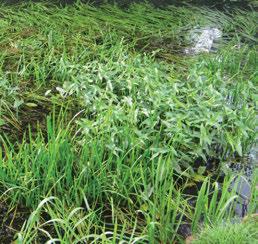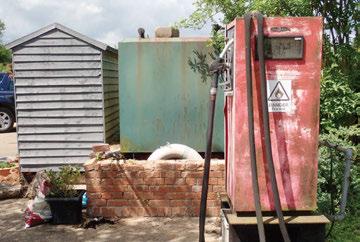
11 minute read
canals in Watercolour
Artist Dave Gardham tells us about his wintry waterways scenes that feature on IWA’s Christmas cards and his love of boating
I’ve been an IWA member for many years and my paintings first appeared on the Association’s Christmas cards in 2013. I had a selection of waterways scenes and thought they would make a good calendar so got in touch with Neil Edwards who advised me to submit a picture for the cards instead. To my surprise, it was accepted and I’ve added a new painting to the collection each year since.
Creative beginnings
I’ve been creating art for as long as I can remember. I used to draw all the time when I was a kid – I loved to draw horses and I’d be sat in class doodling. Once I started painting, I always included water of some kind if I could, as I’m fascinated with the canals, but I do other things too. Years ago I took on commissions as a hobby. I did some family pet portraits and at one time I had quite a number of requests for tigers. It was around the time Esso had the ‘Put a Tiger in Your Tank’ slogan and I got fed up of painting them! People like having their boats painted in a favourite spot, and portraits of anglers holding a net full of fish – probably more than they’d ever caught – were popular as well.
Since being introduced to the waterways, canal scenes have been my favourite things to paint. While out boating, I do some painting and sketching on location if I see a view that I like; I look at the scene and move things around a bit on the page to get the best composition. Mostly, though, I work from photographs. I do the majority of my paintings during winter after we’ve closed up the boat. It can take a month or more to complete a painting, although it probably only takes around two weeks of actual work. You have to have a break or two; coming back to the piece after a few days means you notice things that aren’t quite right that you might not otherwise have seen.
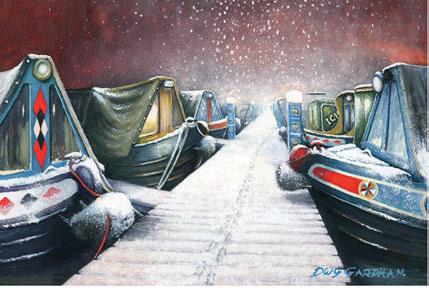
Above: The Packet
House at Worsley is Dave’s personal favourite Christmas card painting.
Right & below:
This painting of Dave’s grandchildren fishing at Great Haywood brings back happy memories.

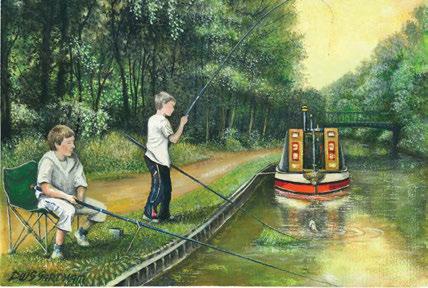
Kings Bromley Marina.
Chirk Aqueduct on the Llangollen Canal.
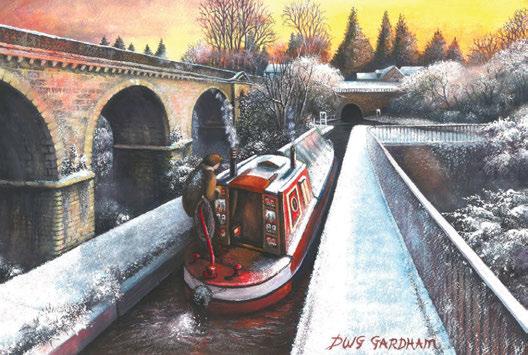
Inspiration
I prefer to use watercolours or gouache, although I have worked with acrylics and I want to get back into painting with oils again this year. I’m a bit of a traditionalist and am inspired by artists like Constable and Gainsborough, but I absolutely love Banksy’s modern work too. I’d describe my style as realism with some interpretation. I like to get the light, perspective, composition and detail as close as I can, then add things like snow to make it wintry. Gouache paint is good for this as you can layer paler colours over the top of darker ones, producing more vivid results than traditional watercolour paintings.
The Christmas card picture I’m most pleased with is the Packet House at Worsley on the Bridgewater Canal. The photograph was taken in mid-July and I used a bit of artistic licence to make it wintry – I wasn’t sat out in the cold. Another painting that brings back nice memories is one I did of my grandchildren. We’d stopped at Great Haywood and the boys were fishing in the canal. Later that evening we listened to a Jools Holland concert that was taking place at the nearby Shugborough Hall and watched the firework display from across the fields. My favourite painting, however, is always the next one – as long as I don’t get bogged down with it. I always start off saying I won’t add in so much detail but then I do – I just can’t help myself.
Going for guild
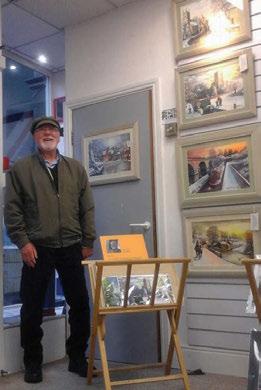
Dave’s paintings on I’ve been a member of the display in Newark. Guild of Waterway Artists for three years. While out on the network, I display my paintings outside the boat and on separate occasions I got talking to two Guild members who suggested I submit my work. It’s a prestigious group as there are only ever 25 members and you have to be voted in, so I was honoured to have been accepted into the Guild straight away. Among the founding members was Alan Firth, whose paintings also appear on IWA’s Christmas cards, and I’d admired his work for years – I’ve even got a few of his wall plates inside the boat.
As part of the Guild, my work is on show alongside that of the other members at various exhibitions around the country including Audlem Mill in Cheshire, Ellesmere Port and the Black Country Living Museum. We keep in touch throughout the year and meet up at the Braunston Historic Narrowboat Rally every summer where we have our own stand. I also have my own display at the Arcade Art Shop in Newark-on-Trent.

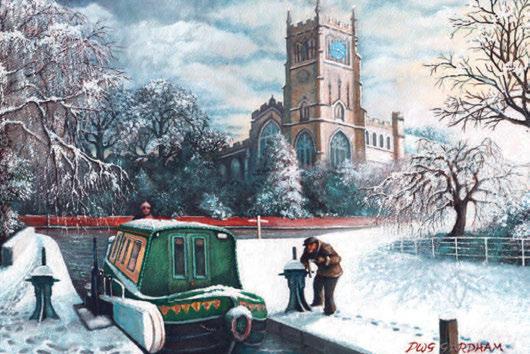
Above: Kidderminster
Church.
Right: Winter in the
Potteries – Dave’s first IWA Christmas card.
below: Cruising
Home for Christmas.


Adventure
During the summer, my wife and I enjoy exploring the network on our narrowboat Eliza Rose (named after my mother-in-law Eliza and wife Rose). We bought the boat around 12 years ago after going on a few hire-boat holidays and we’re now spending as much time as possible cruising the canals while we can. The boat is based at Kings Bromley Marina, which is very rural but also quite central and means we can choose almost any part of the network to visit.
We love the adventure of being out on the waterways and have been to most places except for London. Cruising into Liverpool and staying at the newly opened docks in the middle of the city in 2008 was a memorable experience. We love the area that we’re in too; Tixall Wide is not too far away and Rose recently took a fantastic photograph of it that we’re going to print out to put up on the boat.
Rose at the helm of their boat Eliza Rose.
Then and Now: celebrating restoration success stories Pocklington Canal
Cruising the canal after another stretch was restored in 2018.
The Pocklington Canal is 9½ miles long and currently a little under 7 miles are navigable. It runs through East Riding of Yorkshire from Canal Head near Pocklington, down to the River Derwent, which it joins near East Cottingwith.
The vast majority of the canal (with the exception of a small stretch near Hagg Bridge) lies within designated Sites of Special Scientific Interest. The waterway’s stunning natural surrounds boast three SSSIs, as well as a Special Area of Conservation, Special Protection Area and a Ramsar site (a wetland of international importance).
These internationally recognised protection orders mean that any work undertaken on the canal is subject to an in-depth environmental assessment under the Conservation of Habitats and Species Regulations (2010) and must comply with all rulings.

THEN: the history of the Pocklington Canal
The Pocklington Canal was a late addition to the waterways network of England and Wales. Work did not start until 1815, despite proposals half a century before, and the canal was completed in 1818 at a cost of £32,695. An extension to its eponymous town proved prohibitively expensive, so its terminus remained just a few miles outside of Pocklington.
The canal was mainly used to carry coal and agricultural produce. It was never a great financial success, partly because goods had to be transferred to horse-drawn carts at the terminus of the canal, adjacent to the Hull-York turnpike road, to continue their journey. The canal was sold to the York & North Midland Railway in 1848 and, like many canals in railway ownership, deteriorated through lack of dredging and other maintenance. Subsequently, in the hands of the North Eastern Railway, the canal gradually fell into disuse early in the 20th century and the last commercial craft to use the Pocklington was the keel Ebenezer in 1932.
Pleasure-craft stopped using the canal soon after due to the deterioration of the lock gates, and from the mid 1930s until the early 1960s, the Pocklington was all but forgotten. In 1963, ownership passed to the British Waterways Board.
A proposal, in 1959, to infill the canal with “inoffensive sludge” from a water treatment plant angered landowners, local residents and vocal members of IWA. With support from the Inland Waterways Protection Society, MPs were lobbied, there was extensive publicity in the press and even the House of Commons learned of the Pocklington Canal and its plight. The canal was saved. Waterways enthusiasts began to explore the possibility of restoring the canal and, in 1969, the Pocklington Canal Amenity Society was formed.
Restoration began in 1971 with the repair of the entrance lock near East Cottingwith. In 1980, the Shell Oil Company funded a new set of gates for Thornton Lock, under an awards scheme. Further assistance was provided in 1986 when PCAS provided two swing-bridges and East Yorkshire Borough Council funded the work to fit them.
The canal as far as the Melbourne Arm was formally opened on 19th July 1987 by Brian Dice, chief executive of BWB. In the same year, the first of many WRG Canal Camps was held on the canal.
Negotiations to restore Walbut Lock took months to complete, but permission was finally granted in 1992, and in 1995 PCAS launched a fund for new gates at Coates Lock, which were fitted in 2000. The section nearest to Pocklington benefitted from a new set of bottom gates on the Top Lock in 2002 after which British Waterways dredged the pound above.
A wintry scene on an unrestored section of the Pocklington Canal.

NOW: ongoing restoration and wildlife protection
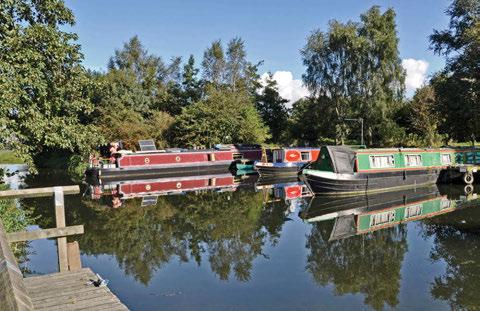
In 2014, WRG visited the Pocklington Canal on two occasions. In March, scrub-bashing took place near Bielby and over a week in August, as part of the Canal Camp programme, much of the towpath between Giles Lock and Sandhill Lock was repaired.
In 2015, a partnership between PCAS and Canal & River Trust, supported by a grant from the National Lottery Heritage Fund, created a three-year ‘Gem in the Landscape’ project. It ran between September 2016 and August 2019 and highlights included the volunteer-led restoration of the Grade II-listed Church Bridge and the installation of new signage to tell the canal’s story to visitors. CRT also carried out substantial dredging and tree works to enhance wildlife habitats within the SSSIs, and the swing-bridge on the Melbourne Arm was modified to reflect its traditional Georgian heritage. The 2018 Bicentenary Appeal, which raised £250,000 that included a grant from the IWA Tony Harrison Legacy Fund, made all this possible.
Restoration work continues with the renovation of the currently derelict Sandhill Lock, with which WRG volunteers will be involved.
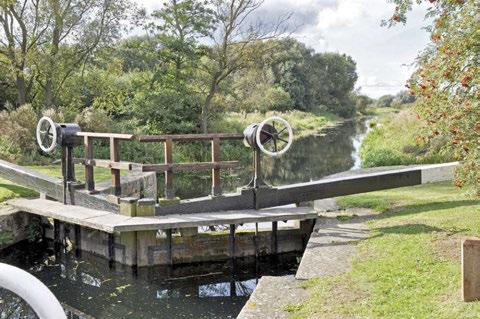
Boats in Melbourne Basin.
The restored Gardham Lock.
Wildlife on the Pocklington Canal
water surface including yellow waterlily, soft hornwort, flatIn March this year, IWA launched its Waterways in Progress stalked pondweed, narrow-leaved water plantain, fan-leaved report which looked at the many different benefits that a water crowfoot, flowering rush and arrowhead. The canal is canal restoration can bring to an area. One of the categories noted for its wide variety of fish stocks, among which can be identified was ‘Enhancing Heritage & Habitats’ and the found tench, bream, perch and roach, as well as its 15-plus Pocklington Canal was used as a case study to show how the species of dragonflies and damselflies, including the rare redrestoration provided a ‘second chance for wildlife’. eyed damselfly. There’s also an impressive range of bird
Ironically, it is almost because of its abandonment life with kingfishers, grey herons, moorhens and coots that the canal is such a treasure trove for wildlife. making regular appearances along the waterway, It remained relatively unchanged for 150 years as well as curlews, barn owls and swans. and so retained many species of flora and The Pocklington Canal was named one of fauna that were lost in other areas. It is now the top sites for spotting wildlife on waterways the sympathetic restoration and ongoing managed by CRT and was chosen management of the natural habitats that have by John Craven of BBC’s led to it being such an environmental success Countryfile as best for story, which is thankfully now fully protected wildlife in his top ten by SSSIs and other designations. Above: Arrowhead is among the British canals.
Along the route, natural banking plants found on the canal. For more provides ideal habitat for water voles and information about the otters, and there is a wealth of important LeFT: Flowering rush. The Pocklington is protected by SSSIs Pocklington Canal, visit aquatic plants that live above and below the and internationally recognised pocklingtoncanalsociety.org.
protection for its variety of wildlife.
